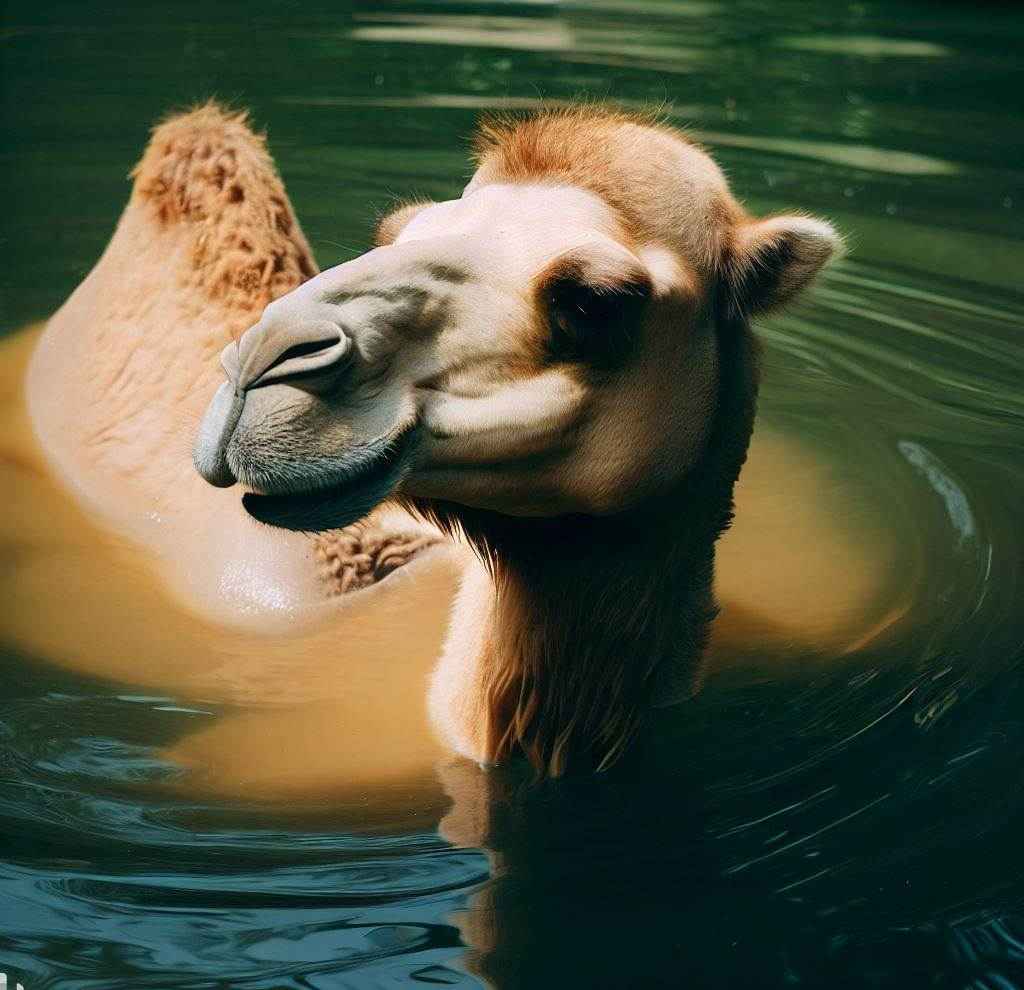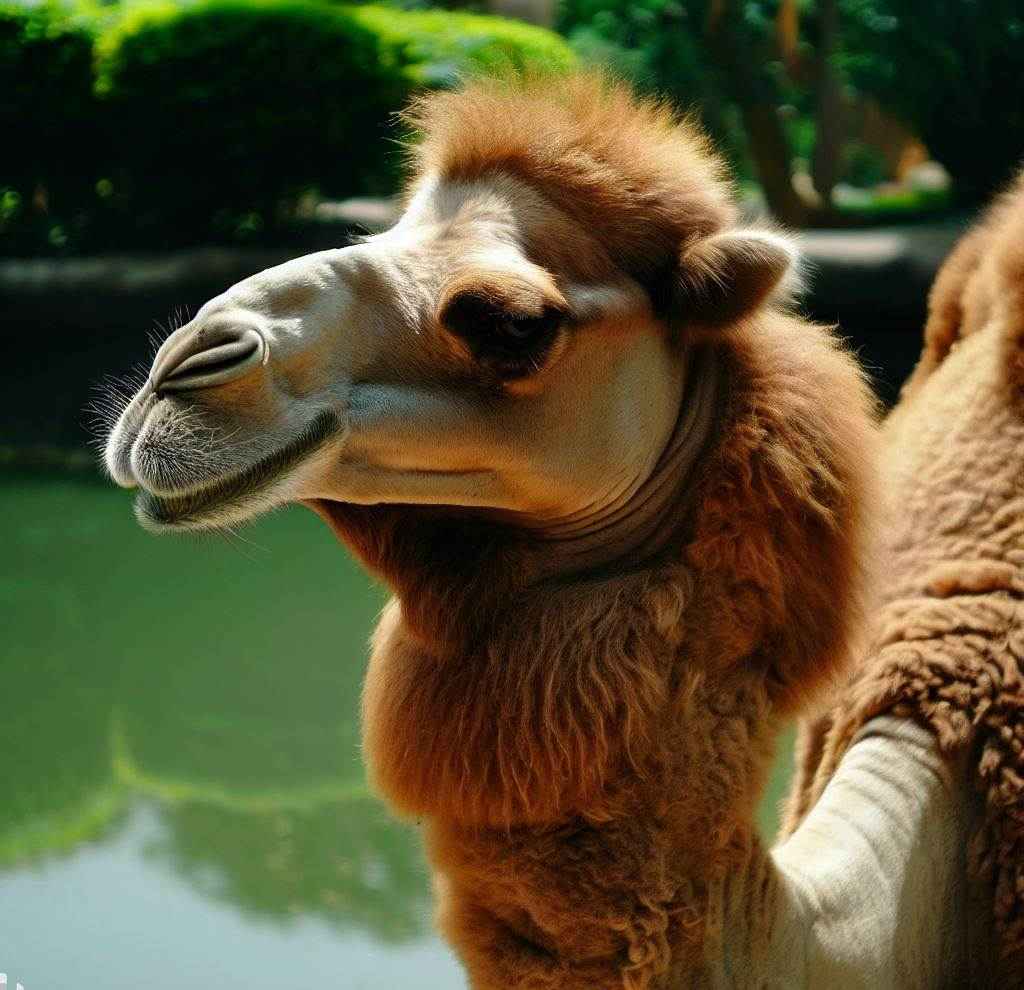How Can Camels Swim?
Can Camels Swim? Camels is being weak swimmers and often drift in hot water to cool off provided there is any available water. They enjoy swimming in the water. Camels is often associated with arid desert landscapes might not seem like natural swimmers but they do possess the surprising ability to swim when the need arises. The key to understanding how camels swim lies in their unique anatomy and clever adaptations. Camels have several features that enable them to navigate through water. Their large, padded feet prevent them from sinking into soft sand, helping with buoyancy in water.
Their woolly fur, while providing insulation against the desert’s extreme temperatures, also traps air, offering natural flotation when they enter the water. When camels swim, they use a circular leg-paddling motion akin to a dog’s paddle. This motion is combined with their buoyant fur and padded feet that allows them to move gracefully through the water, covering surprising distances. However, there are misconceptions about camels storing water in their humps for swimming.
In reality, their humps store fat, not water and their swimming abilities are unrelated to hump contents. Despite not being great swimmers the camels are effective in a variety of conditions including the water, demonstrating their toughness and adaptability. Camels are capable of traversing water when necessary, despite not being your traditional swimming partners.
Introduction:
Camels are renowned as the “ships of the desert” in the vast and dry expanses of deserts. Camels have come to be associated with surviving in difficult circumstances due to their exceptional capacity to survive lengthy journeys through sweltering sand dunes. However, have you ever wondered if these creatures swim? In this blog post, we will explore the fascinating world of camels and delve into the intriguing question: How can camels swim?
Can Camels Swim In Water?
The water is wonderful for swimming with camels. Certainly the camels possess the ability to swim although, it is not their preferred mode of transportation. These resilient desert creatures are renowned for their capacity to endure arid conditions but they can adapt to watery environments when necessary. Camels have several physical adaptations that enable them to swim. Their large, padded feet function effectively to keep them afloat in water preventing them from sinking into soft sand and their woolly fur can trap air, providing buoyancy.
When camels enter the water, they employ a circular leg-paddling motion which is similar to a dog’s paddle by allowing them to move through water reasonably well. However, it is important to clarify a common misconception – camels do not store water in their humps for swimming. Their humps actually store fat, not water and their swimming abilities are unrelated to the hump’s contents. While camels might not revel in swimming, they demonstrate proficiency when faced with water obstacles during their desert journeys.
Their adaptability and unique features make them capable of navigating through diverse landscapes whether it is the scorching sands of the desert or the occasional water crossings they encounter. So, while camels may not be Olympic swimmers and they are undoubtedly more skilled in the water than one might initially assume. They tend to float much of the time since they are not great swimmers. But when it is hot camels will enter the water to cool off. If there is any water around, that is.
Do Camels Dive In Water?
Let’s examine a specific characteristic of camels, their nostrils, which may aid them in diving, before providing a response. Camels do not dive in water. While these remarkable desert animals are capable swimmers when necessary, they do not exhibit diving behaviors commonly associated with aquatic creatures. Camels use a unique leg-paddling motion when in the water by allowing them to stay afloat and move through it effectively. This paddle-like movement is more akin to what you’d observe in a dog swimming.
However, they do not submerge themselves or dive beneath the water’s surface as typical diving animals like dolphins or seals would. Camels’ buoyancy in water is aided by their padded feet, which prevent them from sinking into soft sand or mud at the bottom of bodies of water and their woolly fur, which can trap air, providing additional flotation. These adaptations enable camels to navigate through water bodies, such as rivers or ponds, during their desert journeys or when they encounter unexpected water sources.
The camels are proficient swimmers and their swimming behavior does not include diving. They rely on their unique adaptations to stay afloat and move through the water’s surface when needed, making them fascinating creatures adapted to both arid and aquatic environments. Therefore, when diving it would be better to close the nostrils. There haven’t been any instances of camels diving. Camels have the ability to totally seal their nostrils to keep sand from entering their noses during sandstorms.
How Long Can Camels Swim?
Camels have been observed swimming nearly 1.8 miles (3 km) and can swim up to 10 kilometers (6 miles) according to the Times of Oman. Camels do not dive in water. While these remarkable desert animals are capable swimmers when necessary, they do not exhibit diving behaviors commonly associated with aquatic creatures. Camels use a unique leg-paddling motion when in the water by allowing them to stay afloat and move through it effectively.
This paddle-like movement is more akin to what you’d observe in a dog swimming. However, they do not submerge themselves or dive beneath the water’s surface as typical diving animals like dolphins or seals would. Camels buoyancy in water is aided by their padded feet which prevent them from sinking into soft sand or mud at the bottom of bodies of water and their woolly fur which can trap air, providing additional flotation. These adaptations enable camels to navigate through water bodies such as rivers or ponds, during their desert journeys or when they encounter unexpected water sources.
Camels are proficient swimmers and their swimming behavior does not include diving. They rely on their unique adaptations to stay afloat and move through the water’s surface when needed by making them fascinating creatures adapted to both arid and aquatic environments.
Do Camels Swim Across The Sea?
Camels do not swim across the sea. While camels are impressive swimmers, their swimming capabilities are not suited for crossing vast bodies of water such as oceans. These remarkable desert creatures are adapted for desert survival and are not designed for long-distance swimming in open waters. Even in deep waters, the camels swim great distances to reach their grazing areas—usually more than 3 kilometers at a time. They consume substantial amounts of mangroves and saline plant types. The camels are frequently left on the mangrove islands for three months during the monsoon.
Camels’ swimming abilities are primarily used for crossing smaller bodies of water like rivers, streams, or ponds that they may encounter during their journeys through arid regions. They employ a unique leg-paddling motion and their buoyant features such as padded feet and woolly fur to navigate through these relatively shallow water sources. Crossing the sea would be an entirely different challenge, as it involves navigating deep, open waters for extended periods. Camels lack the specialized adaptations required for such endeavors, like marine mammals or fish possess.
Attempting to swim across the sea would be both physically and biologically taxing for camels, making it an impractical and highly unlikely scenario. The camels are proficient swimmers when it comes to traversing smaller water bodies but they are not equipped for and do not engage in long-distance swimming across the sea. Their swimming abilities are more functional and suited to their desert environment.
Facts & Features Of Camel:
- It is well known that camels can survive and even flourish in dry, hostile settings like deserts.
- Contrary to common assumption, their humps do not contain water instead, they contain fat, which they may digest to provide energy during extended travels through dry areas.
- Camels have one or two humps on their back, with Bactrian camels having two and Dromedary camels having one.
- These humps store energy-rich fat, enabling them to survive without drinking for extended periods. Camels are extremely effective water savers.
- They are able to consume up to 40 gallons of water at once, and since their kidneys concentrate urine to reduce water loss so, they may go for extended periods of time without drinking.
- Camels can swim when necessary, despite their image as desert animals.
- They use a paddle-like leg movement, aided by their buoyant fur and padded feet, to navigate through water bodies.
- Camels, a protected species, have a complex social hierarchy and a relatively long lifespan of up to 40 years in captivity.
- Their endurance and adaptability make them valuable for various tasks, including pack animals and transportation in desert regions.
- Camels, known for their strength and ability to carry heavy loads, are highly valued for their cultural and religious significance in the Middle East and North Africa, and are known for their unique flavor and health benefits.
- They are a staple diet in several places.
- Despite conservation efforts, camels are not seen as being in danger of extinction because of their resilience, adaptability, and special qualities that allow them to endure severe environments.
FAQs:
1 How far can a camel swim?
Camels can swim short to moderate distance typically up to a few hundred meters. Their swimming abilities are more suited for crossing rivers or ponds encountered during their desert journeys, rather than for long-distance swimming. While they’re proficient swimmers within their limits, they’re not built for extensive aquatic endeavors.
2 Can a camel swim?
Yes, camels can swim. While not their preferred activity and they exhibit surprising proficiency when navigating through water using a unique leg-paddling motion, buoyant fur and padded feet. They can handle short to moderate water crossings when needed.
3 Which camel can float on water?
All camel species including the single-humped dromedary and the double-humped Bactrian camel, have the natural ability to float on water. Their buoyant fur, padded feet and paddle-like leg motion allow them to stay afloat and navigate through water effectively, ensuring their survival in desert regions with occasional water sources.
4 Are camels strong swimmers?
Camels are not considered strong swimmers in the traditional sense, but they are proficient when it comes to navigating through water. Their unique adaptations, including padded feet and buoyant fur which enables them to swim with relative ease especially in short to moderate water crossings. However, they are not built for extensive or long-distance swimming.
5 How long can camels hold water?
Camels can hold water for an impressively long time, often going without drinking for up to two weeks. Their highly efficient kidneys help them conserve water by producing concentrated urine, and they can rapidly rehydrate when water becomes available. This remarkable adaptation ensures their survival in the arid desert environments they call home.




